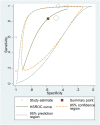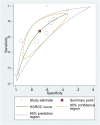The prognostic value of serum neuron-specific enolase in traumatic brain injury: systematic review and meta-analysis
- PMID: 25188406
- PMCID: PMC4154726
- DOI: 10.1371/journal.pone.0106680
The prognostic value of serum neuron-specific enolase in traumatic brain injury: systematic review and meta-analysis
Abstract
Background: Several studies have suggested that neuron-specific enolase (NSE) in serum may be a biomarker of traumatic brain injury. However, whether serum NSE levels correlate with outcomes remains unclear. The purpose of this review was to evaluate the prognostic value of serum NSE protein after traumatic brain injury.
Methods: PubMed and Embase were searched for relevant studies published up to October 2013. Full-text publications on the relationship of NSE to TBI were included if the studies concerned patients with closed head injury, NSE levels in serum after injury, and Glasgow Outcome Scale (GOS) or Extended GOS (GOSE) scores or mortality. Study design, inclusion criteria, assay, blood sample collection time, NSE cutoff, sensitivity and specificity of NSE for mortality prediction (if sufficient information was provided to calculate these values), and main outcomes were recorded.
Results: Sixteen studies were eligible for the current meta-analysis. In the six studies comparing NSE concentrations between TBI patients who died and those who survived, NSE concentrations correlated with mortality (M.D. 0.28, 95% confidence interval (CI), 0.21 to 0.34; I2 55%). In the eight studies evaluating GOS or GOSE, patients with unfavorable outcomes had significantly higher NSE concentrations than those with favorable outcomes (M.D. 0.24, 95% CI, 0.17 to 0.31; I2 64%). From the studies providing sufficient data, the pooled sensitivity and specificity for mortality were 0.79 and 0.50, and 0.72 and 0.66 for unfavorable neurological prognosis, respectively. The areas under the SROC curve (AUC) of NSE concentrations were 0.73 (95% CI, 0.66-0.80) for unfavorable outcome and 0.76 (95% CI, 0.62-0.90) for mortality.
Conclusions: Mortality and unfavorable outcome were significantly associated with greater NSE concentrations. In addition, NSE has moderate discriminatory ability to predict mortality and neurological outcome in TBI patients. The optimal discrimination cutoff values and optimal sampling time remain uncertain because of significant variations between studies.
Conflict of interest statement
Figures












References
-
- Hyder AA, Wunderlich CA, Puvanachandra P, Gururaj G, Kobusingye OC (2007) The impact of traumatic brain injuries: a global perspective. NeuroRehabilitation 22: 341–353. - PubMed
-
- Roozenbeek B, Maas AIR, Menon DK (2013) Changing patterns in the epidemiology of traumatic brain injury. Nat Rev Neurol 9: 231–236. - PubMed
-
- Turgeon AF, Lauzier F, Burns KE, Meade MO, Scales DC, et al. (2013) Determination of neurological prognosis in adult patients with severe traumatic brain injury: a survey of Canadian intensivists, neurosurgeons and neurologists. Crit Care Med 41: 1086–93. - PubMed
-
- Zitnay GA, Zitnay KM, Povlishock JT, Hall ED, Marion DW, et al. (2008) Traumatic brain injury research priorities: The Conemaugh international brain injury symposium. J Neurotrauma 25: 1135–52. - PubMed
Publication types
MeSH terms
Substances
LinkOut - more resources
Full Text Sources
Other Literature Sources

